Click here to learn more about the How to Identify article series.
Name: Fireweed (Chamaenerion angustifolium or Chamerion angustifolium); also may be known as great willowherb or rosebay willowherb. Sometimes categorized in the closely related genus Epilobium instead.
Range and typical habitat(s): Native to much of temperate to boreal Northern Hemisphere, particularly forested areas. This sun-loving plant prefers meadows and other open areas, and can tolerate damp soil as well as weathering summer dry periods. It is a pioneer species that can quickly colonize cleared and burned areas. In its native habitat, this plant can even compete alongside invasive annuals on disturbed land.
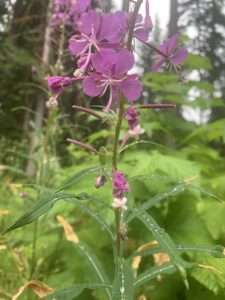
Distinguishing physical characteristics (size, colors, overall shapes, detail shapes): It’s hard to miss a fully-grown fireweed. The slender green stems with a reddish tint can be up to nine feet tall. They have slender, lance-shaped leaves with smooth to very slightly serrated edges about three to five inches long, growing in an alternate pattern (one on one side of the stem, 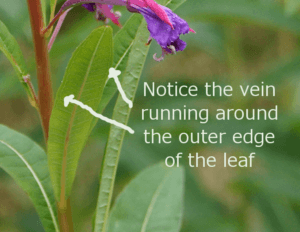 the next on the other a little further up, and so on). The leaves seem to spiral around the stem as they rise; they grow from the base of the plant up to where the raceme begins. A close look at the leaf shows a central vein with many more slender secondary veins branching off of it; the outer ends of these veins then converge again to create a slender vein that runs around the entire outer edge of the leaf.
the next on the other a little further up, and so on). The leaves seem to spiral around the stem as they rise; they grow from the base of the plant up to where the raceme begins. A close look at the leaf shows a central vein with many more slender secondary veins branching off of it; the outer ends of these veins then converge again to create a slender vein that runs around the entire outer edge of the leaf.
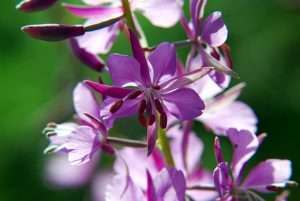 The upper portion of the stem consists of a raceme of flowers; all the flowers grow along the main stem rather than branching out onto sub-stems. The raceme continues to grow even after the first flowers start to develop, and some racemes may be over a foot long. The flowers themselves are pink to light magenta, and are usually not much more than an inch across. They have four broad spoon-shaped petals with small notches in the ends, and four narrow sepals behind that may be seen peeking out of the gaps between the petals. There are eight stamens with dark reddish pollen, and a single central anther. Look for the flowers in the latter half of spring to summer; the plant may bloom later in the year at higher elevations since they get a later start than their lowland counterparts.
The upper portion of the stem consists of a raceme of flowers; all the flowers grow along the main stem rather than branching out onto sub-stems. The raceme continues to grow even after the first flowers start to develop, and some racemes may be over a foot long. The flowers themselves are pink to light magenta, and are usually not much more than an inch across. They have four broad spoon-shaped petals with small notches in the ends, and four narrow sepals behind that may be seen peeking out of the gaps between the petals. There are eight stamens with dark reddish pollen, and a single central anther. Look for the flowers in the latter half of spring to summer; the plant may bloom later in the year at higher elevations since they get a later start than their lowland counterparts.
 When the fireweed’s seeds mature–up to 80,000 per plant–they each have a tiny bit of fluff to help them be carried on the wind. This helps the fireweed to colonize new locations. This species’ seedbank is quite durable and areas that have seen disturbances such as fire or a blowdown due to high winds will often see a flourish of fireweed in subsequent years.
When the fireweed’s seeds mature–up to 80,000 per plant–they each have a tiny bit of fluff to help them be carried on the wind. This helps the fireweed to colonize new locations. This species’ seedbank is quite durable and areas that have seen disturbances such as fire or a blowdown due to high winds will often see a flourish of fireweed in subsequent years.
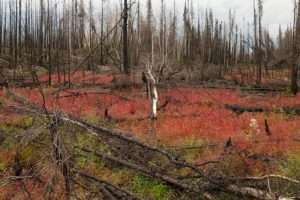
Fireweed gets its name for the brilliant red coloration its leaves develop in the fall. Like other perennial, deciduous plants, it draws nutrients from the leaves back into the roots to be stored over winter. As the chlorophyll in the leaves break down, the green disappears and reveals the bright red of carotenoids.
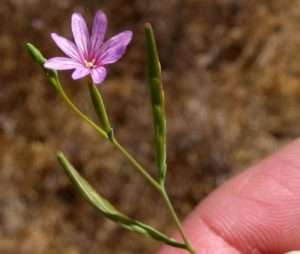
Other organisms it could be confused with and how to tell the difference: Fireweed does resemble some other plants in the genera Chamaenerion or Epilobium, but it is much taller than most of them. Tall willowherb (Epilobium brachycarpum), also known as panicled willowherb, is a close lookalike at first glance. But its leaves are shorter and more dense, and the long edges often seem to roll up toward the center, whereas fireweed’s leaves tend to be flatter. Moreover, tall willowherb’s flowers have four petals that have such deep notches in the center that it creates the appearance of an eight-petaled flower instead.
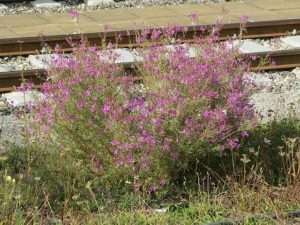
Other willowherbs, such as Chamaenerion dodonaei, may also approach fireweed in height, but tend to grow in a bush shape rather than a collection of single tall stems. There are subtle differences in flower shapes and sizes among similar species as well. For example, the petals of C. dodonaei and C. colchicum lack a notch at the end.
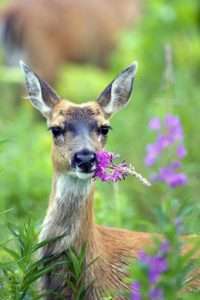
Anything else worth mentioning? The leaves and shoots of young fireweed are edible, but may have a bitter taste that many find unpalatable. The flowers are often made into jelly or candy, and the dried leaves are made into tea (this reportedly has a laxative effect, so don’t overdo it!) Some foragers also extract the sweetish center of the stem to add into soup, or eat raw. As with all foraged wild foods, try a small amount first, properly prepared, and then wait a couple of days to make sure you don’t end up with any adverse reactions. As fireweed is a native plant, do not take any more than you need and leave as much for the ecosystem as you can.
Further reading:
Fireweed: Alaska’s Summer Clock is Ticking
